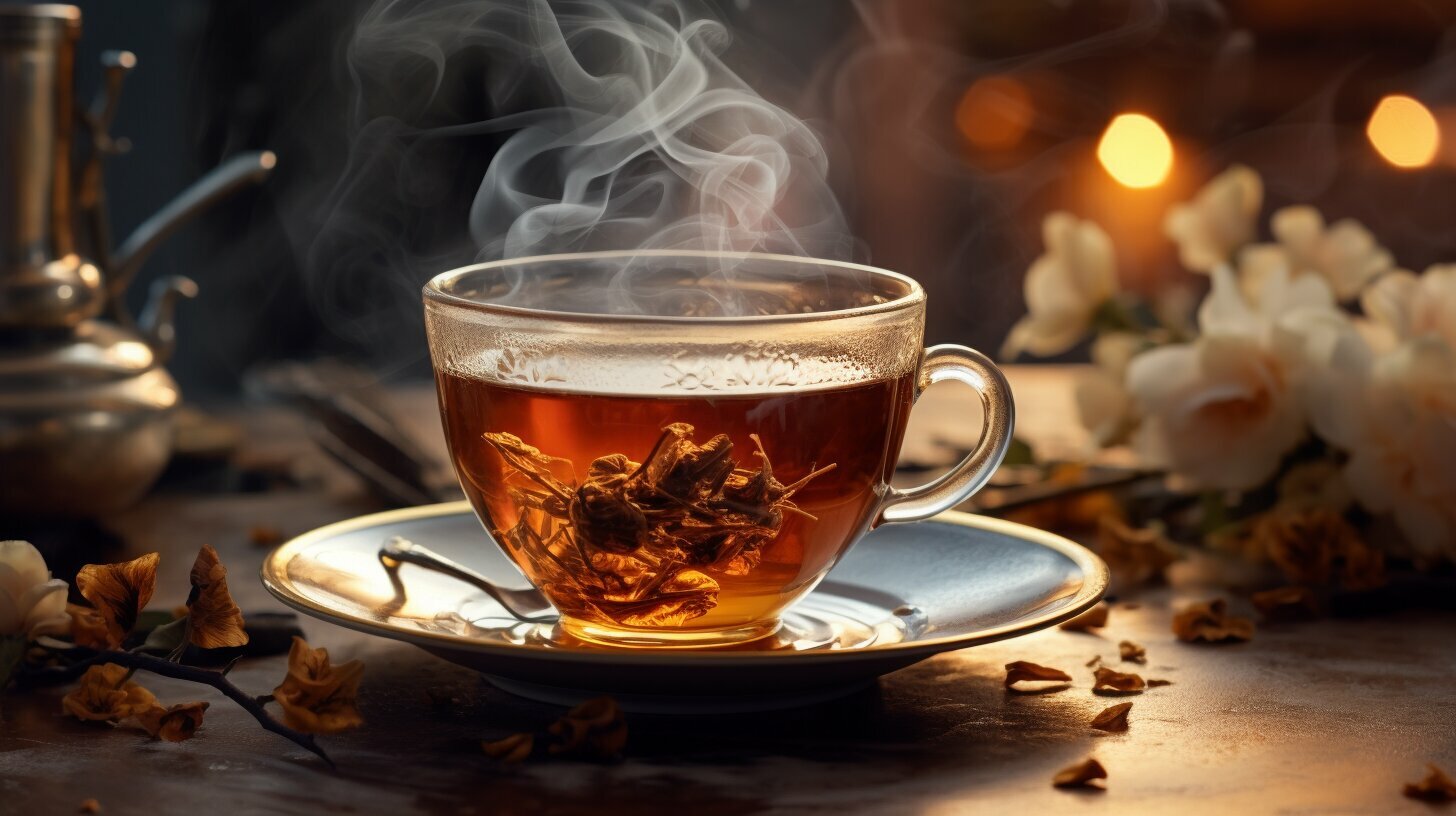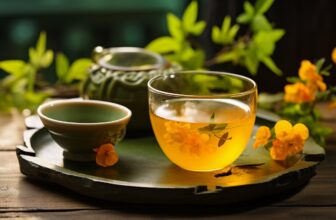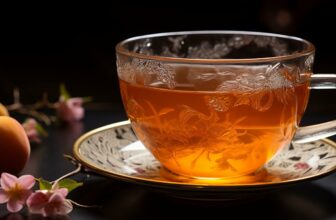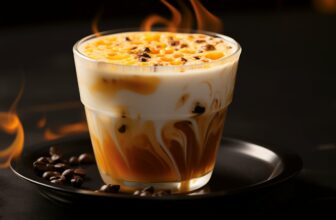
When it comes to tea, there are endless possibilities for flavor combinations. One question that often arises is whether oolong tea tastes good with milk. In this article, I will explore the taste of oolong tea, its compatibility with milk, and provide insights on the topic.
Oolong tea, made from the leaves of the Camellia Sinensis plant, falls between green tea and black tea in terms of flavor. With its unique taste profile, oolong tea offers a delightful range of flavors, from succulent sweetness to floral or nutty notes. However, oolong tea is not typically flavored with additives like milk powder.
While some teas, like black tea, are commonly enjoyed with milk, oolong tea does not have enough tannins to marry well with milk. The absence of tannins allows oolong tea to shine with its distinct flavors and complexities.
It is generally recommended to enjoy oolong tea without milk to fully appreciate its natural taste. However, if you desire a milk-like flavor, there are natural oolong tea varieties, like milk oolong tea, that offer a creamy and milky taste without the need for actual milk additives.
Key Takeaways:
- Oolong tea falls between green tea and black tea in terms of flavor.
- The taste of oolong tea can range from succulent sweetness to floral or nutty flavors.
- Oolong tea does not have enough tannins to marry well with milk.
- Milk oolong tea provides a naturally creamy and milky taste without the need for milk additives.
- It is generally recommended to enjoy oolong tea without milk to fully appreciate its natural flavors.
What is Oolong Tea?
Oolong tea is a type of tea that is made from the leaves of the Camellia Sinensis plant. It falls between green tea and black tea in terms of flavor and oxidation level. Oolong tea is skillfully crafted to bring out the complex flavors in the tea leaves. It is known for its rich taste, which is milder than black tea but stronger than green tea.
Unlike flavored teas, oolong tea is not artificially flavored with additives. Its unique flavors come naturally from the tea leaves themselves, as well as the skillful crafting process. The different varieties of oolong tea, such as Chinese Iron Goddess of Mercy and Da Hong Pao, have their own distinct flavor profiles, ranging from floral and fruity to nutty and woody.
The Camellia Sinensis leaves used to make oolong tea are sourced from various regions, including China and Taiwan. These regions have different terroirs, which include factors such as soil pH, elevation, rainfall, and sunlight exposure. The terroir, along with the oxidation level and tea crafting techniques, influences the flavor and aroma of oolong tea.
“Oolong tea is skillfully crafted to bring out the complex flavors in the tea leaves.”
To brew oolong tea, traditional Chinese methods such as using a gaiwan or a teapot can be employed. The brewing time can be adjusted according to personal preference, with shorter infusion times resulting in a milder and sweeter cup, while longer infusion times can bring out more robust flavors. It is worth noting that oolong tea does not have enough tannins to marry well with milk, so it is generally enjoyed without milk.
In conclusion, oolong tea is a flavorful and versatile type of tea that offers a wide range of tasting experiences. Its unique flavors and aromas are derived naturally from the tea leaves themselves and the intricate crafting process. By exploring the different varieties of oolong tea, one can discover a world of diverse and delightful flavors.
Factors Influencing the Flavor of Oolong Tea
Oolong tea is known for its diverse range of flavors, and these flavors are influenced by several factors. Let’s explore the key elements that contribute to the unique taste of oolong tea.
Oxidation Level:
The oxidation level of oolong tea plays a significant role in defining its flavor profile. Low oxidation oolong teas, such as yellow or golden oolongs, have greener and sweeter flavors. Examples include Chinese Iron Goddess of Mercy and Golden Lily Milk Oolong. On the other hand, oolong teas like Sunset Oolong from Taiwan and New Zealand oolong are oxidized further, revealing deeper tropical fruit notes. Da Hong Pao, the most oxidized oolong tea, boasts a dark amber color and a flavor profile that includes nutty chocolate.
Terroir:
The terroir, which encompasses environmental factors like soil pH, elevation, rainfall, and sunlight exposure, also influences the flavor of oolong tea. The exact location where the tea is grown contributes to the unique characteristics of the tea leaves. China and Taiwan are renowned for producing exceptional oolong teas, each with its own distinct flavor profile.
Tea Crafting:
The tea master’s expertise in crafting the tea is another crucial factor in the flavor of oolong tea. The skillful processing techniques, which involve plucking, withering, oxidation, and firing, contribute to the development of flavors in the leaves. It is the tea master’s artistry that brings out the complex and nuanced taste of oolong tea.
The Camellia Sinensis Plant:
The oolong tea leaves are derived from the Camellia Sinensis plant, which is also responsible for green tea and black tea. However, the unique processing methods used for oolong tea result in a distinct flavor profile that sits between the delicate taste of green tea and the robustness of black tea.
| Factors Influencing Oolong Tea Flavor | Examples |
|---|---|
| Oxidation Level | – Low oxidation oolong teas: Chinese Iron Goddess of Mercy, Golden Lily Milk Oolong – Higher oxidation oolong teas: Sunset Oolong, New Zealand oolong – Most oxidized oolong tea: Da Hong Pao |
| Terroir | – China: Various oolong teas with distinctive flavors – Taiwan: Renowned for producing high-quality oolong teas |
| Tea Crafting | – Skillful processing techniques by tea masters |
| The Camellia Sinensis Plant | – Derived from the same plant as green tea and black tea |
Understanding these factors can enhance your appreciation for the intricate flavors found in oolong tea. Whether you prefer the floral sweetness of a lightly oxidized oolong or the deep, nutty notes of a heavily oxidized variety, exploring different oolong teas can be an exciting and enjoyable journey to embark on.
What Does Oolong Tea Taste Like?
Oolong tea offers a diverse range of flavors, making it a delight to explore for tea enthusiasts. Each oolong tea has its own unique tasting notes, providing a complex and exciting experience for the palate. Floral flavors are commonly found in oolong teas, adding a delicate and aromatic touch to the cup. Some oolong teas may have tasting notes that resemble the fragrance of blooming flowers, such as orchids or jasmine.
Aside from floral flavors, oolong tea can also exhibit nutty flavors that bring a delightful richness to the brew. These notes can range from subtle hints of roasted nuts to more pronounced flavors like almond or walnut. The nuttiness adds depth and complexity to the overall taste profile of the oolong tea.
Additionally, oolong tea can have a succulent sweetness that is truly satisfying. This natural sweetness can range from mild to pronounced, depending on the specific oolong tea variety and its processing. It provides a pleasant contrast to the other nuanced flavors, resulting in a well-balanced and enjoyable cup of tea.
Comparison of Oolong Tea Flavor Profiles
| Oolong Tea Variety | Tasting Notes |
|---|---|
| Chinese Iron Goddess Oolong | Succulent sweetness with floral notes |
| Rare Pipachá Oolong | Dried fruits and honey with an elegant port wine nose and finish |
| Da Hong Pao Oolong | Dark amber color with deep flavors of nutty chocolate |
These are just a few examples of the various flavor profiles that oolong tea can offer. It’s important to note that the oxidation level and terroir of the tea can greatly influence its taste. Exploring different oolong teas allows you to discover the flavors that resonate with your preferences and experience the full spectrum of this remarkable tea.
Is Oolong Tea Flavored?
Oolong tea is not typically flavored with additives like milk powder. The unique flavors of oolong tea come from the leaves themselves and the expert crafting process. Exceptionally crafted loose leaf oolong tea does not need any artificial or natural flavorings added to it. The natural aromas and flavors of oolong tea varietals shine through without any additional flavorings. Milk oolong tea, for example, has a wonderful aroma of warm milk, but this aroma comes naturally from the tea varietal and the skillful crafting process. It is important to source high-quality oolong teas that do not use artificial flavorings to fully appreciate and enjoy the natural flavors of the tea.
“Exceptionally crafted loose leaf oolong tea does not need any artificial or natural flavorings added to it.”
When it comes to flavored oolong teas, it’s important to note that any additional flavors are not used to mask or enhance the flavor of the tea itself, but rather to create unique taste experiences. For example, some oolong teas may be flavored with natural ingredients like fruits, flowers, or herbs to create delightful flavor combinations. These flavored oolong teas can offer a refreshing twist to traditional oolong tea while still maintaining the essence of the tea’s natural flavors.
Types of Flavored Oolong Teas
- Fruit-Infused Oolong Teas
- Floral Oolong Teas
- Herbal Oolong Teas
Flavored oolong teas can be enjoyed by those who prefer a unique and adventurous tea-drinking experience. However, it is important to choose flavored oolong teas that use natural flavors and high-quality oolong tea as the base. This ensures that you are getting the best of both worlds – the natural flavors of oolong tea complemented by carefully selected and blended additional flavors.
| Flavor | Description |
|---|---|
| Fruit-Infused | Oolong tea blended with natural fruit flavors, offering a fruity and refreshing taste. |
| Floral | Oolong tea combined with floral ingredients like jasmine, rose, or osmanthus, creating a delicate and aromatic experience. |
| Herbal | Oolong tea infused with herbs like mint, chamomile, or lemongrass, providing a soothing and herbal flavor. |
“Flavored oolong teas can be enjoyed by those who prefer a unique and adventurous tea-drinking experience.”
Ultimately, the choice between regular oolong tea and flavored oolong tea comes down to personal preference. Some tea enthusiasts prefer to experience the pure, unadulterated flavors of oolong tea, while others enjoy exploring the creative blends and flavor combinations that flavored oolong teas offer. Whichever option you choose, be sure to select high-quality teas that are crafted with care and use natural flavors.
Health Benefits of Oolong Tea
Oolong tea offers a multitude of health benefits due to its high concentration of antioxidants and polyphenols. These powerful compounds help protect the body from oxidative stress and inflammation, promoting overall well-being and vitality. Here are some of the key health benefits associated with consuming oolong tea:
1. Weight Loss
Oolong tea has been found to boost metabolism and promote fat oxidation, making it a popular choice for those looking to shed a few pounds. Regular consumption of oolong tea can help increase calorie burning and improve fat-burning efficiency, supporting weight loss efforts when combined with a balanced diet and exercise.
2. Dental Health
The natural fluoride content in oolong tea helps strengthen tooth enamel and prevent tooth decay. Regularly drinking oolong tea can contribute to improved dental health, reducing the risk of cavities and gum disease.
3. Bone Health
Studies have shown that oolong tea may have a positive effect on bone health, contributing to increased bone mineral density and reducing the risk of osteoporosis. The combination of antioxidants and minerals in oolong tea helps support healthy bones and may help prevent age-related bone loss.
4. Mental Alertness
Oolong tea contains caffeine and theanine, which can enhance cognitive function, improve focus, and increase alertness. The combination of these two compounds provides a balanced and sustained energy boost without the jitters often associated with other caffeinated beverages.
5. Heart Health
The antioxidants in oolong tea, such as catechins and flavonoids, have been linked to improved heart health. Regular consumption of oolong tea may help reduce blood pressure levels, lower the risk of heart disease, and improve overall cardiovascular function.
6. Diabetes Prevention
Oolong tea has been shown to have potential benefits in preventing and managing type 2 diabetes. The polyphenols in oolong tea help regulate blood sugar levels, improve insulin sensitivity, and reduce the risk of developing diabetes by promoting healthy glucose metabolism.
7. Cancer Prevention
Research suggests that the antioxidants in oolong tea may help protect against certain types of cancer. The polyphenols in oolong tea have been shown to have anti-cancer properties, inhibiting the growth of cancer cells and reducing the risk of tumor formation.
8. Skincare
Oolong tea contains antioxidants that help protect the skin from damage caused by free radicals and UV radiation. Regular consumption of oolong tea, along with a healthy skincare routine, can promote youthful-looking skin, reduce the appearance of fine lines and wrinkles, and improve overall skin health.
By incorporating oolong tea into your daily routine, you can enjoy these potential health benefits while savoring the delicious flavors and aromas of this remarkable tea.
Table: Health Benefits of Oolong Tea
| Health Benefit | Description |
|---|---|
| Weight Loss | Boosts metabolism and promotes fat oxidation |
| Dental Health | Strengthens tooth enamel and prevents tooth decay |
| Bone Health | Increases bone mineral density and reduces the risk of osteoporosis |
| Mental Alertness | Enhances cognitive function and improves focus |
| Heart Health | Reduces blood pressure levels and improves cardiovascular function |
| Diabetes Prevention | Regulates blood sugar levels and improves insulin sensitivity |
| Cancer Prevention | Protects against certain types of cancer and inhibits tumor growth |
| Skincare | Protects the skin from damage caused by free radicals and UV radiation |
How to Brew Oolong Tea
When it comes to brewing oolong tea, there are a few different methods you can try. One popular method is to use a gaiwan, a traditional Chinese tea brewing vessel. To brew oolong tea using a gaiwan, start by preheating the gaiwan with hot water. Then, add the tea leaves to the gaiwan and pour hot water over them. Let the tea steep for the desired amount of time, typically between 1 and 5 minutes, depending on the desired strength of the tea. Finally, pour the tea into your cup, using the lid of the gaiwan to hold back the tea leaves. This method allows you to fully experience the flavors and aromas of the oolong tea.
Another common method for brewing oolong tea is to use a teapot. Simply add the tea leaves to the teapot and pour hot water over them. Let the tea steep for the desired amount of time, typically between 2 and 4 minutes. Then, pour the tea into your cup, using a strainer if necessary to remove any tea leaves. This method is convenient and works well for both small and large servings of oolong tea.
When brewing oolong tea, it’s important to consider the infusion time. A shorter infusion time will result in a softer, sweeter cup, while a longer infusion time can bring out more bitter notes. It’s a good idea to experiment with different infusion times to find the flavor profile that you enjoy the most. Keep in mind that oolong tea will never have enough tannins to marry well with milk, so it’s generally recommended to enjoy it without adding milk. However, if you’re looking for a milk-like flavor, there are milk oolong teas available that naturally have a creamy and milky taste without the need for actual milk additives.
Summary:
- To brew oolong tea, you can use a gaiwan or a teapot.
- When using a gaiwan, preheat it, add the tea leaves, pour hot water, and let it steep for 1-5 minutes.
- When using a teapot, add the tea leaves, pour hot water, and let it steep for 2-4 minutes.
- Experiment with different infusion times to find your preferred flavor profile.
- Enjoy oolong tea without milk, but consider trying milk oolong teas for a naturally creamy taste.
Where to Buy Oolong Tea
When it comes to purchasing oolong tea, it’s important to choose a reputable source that offers high-quality teas. One such source is Rare Tea, a trusted provider of exceptional oolong teas sourced directly from farmers worldwide. With a wide selection of oolong teas, Rare Tea offers an array of flavors and experiences to explore.
Browsing online tea shops and specialty stores can also provide a range of options for oolong tea enthusiasts. However, it’s essential to be discerning and ensure that the source prioritizes responsible and ethical relationships with farmers. This commitment guarantees the authenticity and quality of the teas and supports sustainable tea production practices.
Tables are an effective way to visually showcase information. Here is a table highlighting the key features of purchasing oolong tea from Rare Tea:
| Features | Rare Tea |
|---|---|
| Tea Selection | Wide variety of oolong teas sourced directly from farmers |
| Quality Assurance | Commitment to providing high-quality, authentic teas |
| Sustainability | Focus on responsible and ethical relationships with farmers |
| Global Shipping | Convenient delivery of oolong teas to your doorstep |
By ensuring that you purchase oolong tea from reputable sources like Rare Tea, you can fully enjoy the authentic flavors and benefits of this delightful beverage. So, whether you’re a seasoned oolong tea enthusiast or just starting to explore its flavors, make sure to choose a reliable source that offers exceptional teas.
Conclusion
In conclusion, oolong tea is a versatile and flavorful beverage that offers a wide range of tasting experiences. While it is generally recommended to enjoy oolong tea without milk, there is a natural variety called milk oolong tea that provides a unique creamy flavor. For those who prefer a milk-like taste, milk oolong tea is a great option.
Oolong tea itself has a complex flavor profile that can range from floral and fruity to nutty and woody. The oxidation level and terroir of the tea play a significant role in determining its taste. Exploring different types of oolong tea can be a delightful journey of discovering new flavors.
Aside from its taste, oolong tea also offers numerous health benefits. It is known to aid in weight loss, improve dental and bone health, enhance mental alertness, promote heart health, and potentially prevent certain diseases. It is a beverage that can contribute to a balanced and healthy lifestyle.
When purchasing oolong tea, it is important to source it from reputable suppliers like Rare Tea, who prioritize quality and sustainable tea production practices. This ensures that you are getting the best oolong tea and supporting responsible farming methods.
FAQ
Does Oolong Tea Taste Good with Milk?
Oolong tea does not have enough tannins to marry well with milk, so it is generally recommended to enjoy it without adding milk. However, if a milk-like flavor is desired, there are naturally creamy and milky oolong tea varieties available, such as milk oolong tea.
What is Oolong Tea?
Oolong tea is a type of tea made from the leaves of the Camellia Sinensis plant. It falls between green tea and black tea in terms of flavor and oxidation level. Oolong tea is crafted to bring out the complex flavors in the tea leaves.
What Factors Influence the Flavor of Oolong Tea?
The flavor of oolong tea is influenced by factors such as the oxidation level, terroir, and tea crafting process. The oxidation level determines the level of sweetness and fruitiness, while the terroir includes environmental factors like soil pH and elevation. The tea crafting process plays a significant role in shaping the final flavor.
What Does Oolong Tea Taste Like?
Oolong tea offers a wide range of flavors, with tasting notes varying from floral and fruity to nutty and woody. The exact taste depends on the specific oolong tea variety, oxidation level, and terroir.
Is Oolong Tea Flavored?
Oolong tea is not typically flavored with additives. The unique flavors of oolong tea come naturally from the tea leaves and the expert crafting process. However, there are flavored oolong teas available, but they use natural flavorings derived from the tea varietals themselves.
What are the Health Benefits of Oolong Tea?
Oolong tea offers numerous health benefits, including weight loss, improved dental and bone health, increased mental alertness, improved heart health, prevention of diabetes, protection against certain types of cancer, and potential benefits for skin health. Regular consumption can have positive effects on overall well-being.
How to Brew Oolong Tea?
Oolong tea can be brewed using traditional Chinese methods like the gaiwan or in a teapot. The infusion time can be adjusted depending on personal preference and desired strength. Shorter infusion times result in a softer, sweeter cup, while longer infusion times can bring out more bitter notes.
Where to Buy Oolong Tea?
Reputable sources like Rare Tea offer high-quality oolong teas that have been directly sourced from farmers around the world. It is recommended to buy oolong tea from tea specialists who prioritize responsible and ethical relationships with farmers to ensure the authenticity and quality of the tea.











